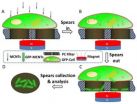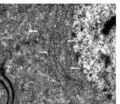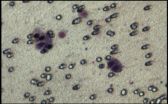University of Houston researchers create new method to draw molecules from live cells
Technique using magnetic nanomaterials offers promise for diagnosis, gene therapy
2014-07-17
(Press-News.org) University of Houston researchers have devised a new method for extracting molecules from live cells without disrupting cell development, work that could provide new avenues for the diagnosis of cancer and other diseases.
The researchers used magnetized carbon nanotubes to extract biomolecules from live cells, allowing them to retrieve molecular information without killing the individual cells. A description of the work appears this week in the Proceedings of the National Academy of Sciences.
Most current methods of identifying intracellular information result in the death of the individual cells, making it impossible to continue to gain information and assess change over time, said Zhifeng Ren, M.D. Anderson Chair professor of physics and principal investigator at the Center for Superconductivity at UH and lead author of the paper. The work was a collaboration between Ren's lab and that of Paul Chu, T.L.L. Temple Chair of Science and founding director of the Texas Center for Superconductivity.
Other key researchers on the project included Xiaoliu Zhang, a cancer researcher with the UH Center for Nuclear Receptors and Cell Signaling, and Dong Cai, assistant professor of physics.
Chu, a co-author of the paper, said the new technique will allow researchers to draw fundamental information from a single cell.
"Now, (most) techniques break up many cells to extract the material inside the cells, so what you get is the average over many cells," he said. "The individual cells may be different, but you cannot see exactly how they function."
The researchers said the steps outlined in the paper offer proof of concept. Ren said the next step "will be more study of the biological and chemical processes of the cell, more analysis."
The initial results hold promise for biomedicine, he said. "This shows how nanoscience and nanoengineering can help the medical field."
Cai said the new method will be helpful for cancer drug screening and carcinogenesis study, as well as for studies that allow researchers to obtain information from single cells, replacing previous sampling methods that average out cellular diversity and obscure the specificity of the biomarker profiles.
In the paper, the researchers explain their rationale for the work – most methods for extracting molecular information result in cell death, and those that do spare the cell carry special challenges, including limited efficiency.
This method is relatively straightforward, requiring the use of magnetized carbon nanotubes as the transporter and a polycarbonate filter as a collector, they report. Cells from a human embryonic kidney cancer cell line were used for the experiment.
The work builds on a 2005 paper published by Ren's group in Nature Methods, which established that magnetized carbon nanotubes can deliver molecular payloads into cells. The current research takes that one step further to move molecules out of cells by magnetically driving them through the cell walls.
The carbon nanotubes were grown with a plasma-enhanced chemical vapor deposition system, with magnetic nickel particles enclosed at the tips. A layer of nickel was also deposited along the surface of individual nanotubes in order to make the nanotubes capable of penetrating a cell wall guided by a magnet.
INFORMATION:
ELSE PRESS RELEASES FROM THIS DATE:
Study: Hour-long home coaching decreases re-admission, costs for Medicare patients
2014-07-17
CLEVELAND -- A new study in Journal of General Internal Medicine reports that an hour-long educational coaching session and two or three follow-up phone calls after a hospital stay reduced re-admission odds by 39 percent among Medicare patients. The study also found that the average cost of care was reduced by $3,700 per patient for those patients who received the education session versus those who did not.
This study is the first to report on a more comprehensive picture of healthcare use in the six months following the patient-centered coaching, called Care Transitions ...
Splice-switching oligonucleotide therapeutics is new method for editing gene transcript
2014-07-17
Splice-Switching Oligonucleotide Therapeutics Is Promising New Method for Editing Gene Transcripts
New Rochelle, NY, July 17, 2014—In splice-switching, an innovative therapeutic approach, targeted oligonucleotide drugs alter the editing of a gene transcript to produce the desired form of a protein. Developments in this rapidly advancing field have already led to promising treatments for such diseases as Duchenne Muscular Dystrophy and spinal muscular atrophy, as described in an article in Human Gene Therapy, a peer-reviewed journal from Mary Ann Liebert, Inc., publishers. ...
Preventing foodborne illness, naturally -- with cinnamon
2014-07-17
PULLMAN, Wash. – Seeking ways to prevent some of the most serious foodborne illnesses caused by pathogenic bacteria, two Washington State University scientists have found promise in an ancient but common cooking spice: cinnamon.
Recent findings published in Food Control journal online suggest Cinnamomum cassia oil can work effectively as a natural antibacterial agent in the food industry. The study results add to a body of knowledge that will help improve food safety and reduce or eliminate cases of food poisoning and related deaths.
In the study, the essential oil ...
Anti-tank missile detector joins the fight against malaria
2014-07-17
State-of-the-art military hardware could soon fight malaria, one of the most deadly diseases on the planet.
Researchers at Monash University and the University of Melbourne have used an anti-tank Javelin missile detector, more commonly used in warfare to detect the enemy, in a new test to rapidly identify malaria parasites in blood.
Scientists say the novel idea, published in the journal Analysis, could set a new gold standard for malaria testing.
The technique is based on Fourier Transform Infrared (FITR) spectroscopy, which provides information on how molecules ...
Acupuncture and moxibustion reduces neuronal edema in Alzheimer's disease rats
2014-07-17
Aberrant Wnt signaling is possibly related to the pathological changes in Alzheimer's disease (AD). Axin and β-catenin protein is closely related to Wnt signaling. Zhou Hua and his team, Hubei University of Chinese Medicine, China confirmed that moxibustion or electroacupuncture, or both, at Baihui (GV20) and Shenshu (BL23) acupoints decreased axin protein expression, increased β-catenin protein expression, and alleviated neuronal cytoplasmic edema. These findings suggest that the mechanism underlying the neuroprotective effect of acupuncture in AD is associated ...
Who are responsible for protecting against neuron and synapse injury in immature rats?
2014-07-17
Fructose-1,6-diphosphate is a metabolic intermediate that promotes cell metabolism. Whether it can alleviate hippocampal neuronal injury caused by febrile convulsion remains unclear. Dr. Jianping Zhou, the Second Affiliated Hospital, Medical College of Xi'an Jiaotong University, China and his team established a repetitive febrile convulsion model in rats aged 21 days, equivalent to 3 years in humans, intraperitoneally administered fructose-1,6-diphosphate at 1,000 mg/kg into the rat model. Results showed that high-dose fructose-1,6-diphosphate reduced mitochondrial ...
Chemokine receptor 4 gene silencing blocks neuroblastoma metastasis in vitro
2014-07-17
Chemokine receptor 4 is a chemokine receptor that participates in tumor occurrence, growth and metastasis in vitro and its expression is upregulated during neuroblastoma metastasis. Dr. Xin Chen, the Affiliated Hospital of Qingdao University, China successfully constructed chemokine receptor 4 sequence-specific small interfering RNA (siRNA) plasmids, transfected into SH-SY5Y cells and found that down-regulation of chemokine receptor 4 can inhibit in vitro invasion of neuroblastoma. This paper was published in Neural Regeneration Research (Vol. 9, No. 10, 2014).
Article: ...
Intrathecal bumetanide has analgesic effects through inhibition of NKCC1
2014-07-17
Accumulating evidence has demonstrated that the sodium-potassium-chloride co-transporter 1 (NKCC1) and potassium-chloride co-transporter 2 (KCC2) have a role in the modulation of pain transmission at the spinal level through chloride regulation in the pain pathway and by effecting neuronal excitability and pain sensitization. Dr. Yanbing He Zhujiang Hospital, Southern Medical University, China and his team found that intrathecal bumetanide could increase NKCC1 expression and decrease KCC2 expression in spinal cord neurons of rats with incisional pain. The authors presumed ...
Attenuated inhibition of neuron membrane excitability contributes to childhood depression
2014-07-17
Accumulating evidence suggests that the nucleus accumbens, which is involved in mechanisms of reward and addiction, plays a role in the pathogenesis of depression and in the action of antidepressants. Dandan Liu and her team, Bio-X Institute, Shanghai Jiao Tong University, China for the first time using electrophysiological method studied the signaling transduction pathway mediated by dopamine D2-like receptor in the medium spiny neurons in the core of the nucleus accumbens in the juvenile Wistar Kyoto rat model of depression. They concluded that impaired inhibition of ...
NYU research on persons w/ HIV/AIDS not taking medication and not engaged in care
2014-07-17
Regular attendance at HIV primary care visits and high adherence to antiretroviral therapy (ART) are vital for people living with HIV/AIDS (PLHA), as these health behaviors lead to lowered rates of morbidity and mortality, increased quality of life, and reducing the risk of HIV transmission to others. However, a large proportion of PLHA in the United States are not sufficiently engaged in care and not taking ART when it is medically necessary.
A new study, "HIV-infected individuals who delay, decline, or discontinue antiretroviral therapy: Comparing clinic- and peer-recruited ...
LAST 30 PRESS RELEASES:
Missed signals: Virginia’s septic strategies overlook critical timing, study warns
Delayed toxicities after CAR T cell therapy for multiple myeloma are connected and potentially preventable
Scientists find cellular key to helping plants survive in saltwater
Medical cannabis program reduces opioid use
Immunotherapy works for sepsis thanks to smart patient selection
Cardiovascular events 1 year after RSV infection in adults
US medical prices and health insurance premiums, 1999-2024
Medical cannabis and opioid receipt among adults with chronic pain
Multichannel 3D-printed bioactive scaffold combined with siRNA delivery for spinal cord injury recovery
Triaptosis—an emerging paradigm in cancer therapeutics
A new paradigm in spectroscopic sensing: The revolutionary leap of SERS-optical waveguide integration and ai-enabled ultra-sensitive detection
Sweet tooth: How blood sugar migration in diabetes affects cavity development
Lowest suicide rate is in December but some in media still promote holiday-suicide myth
Record-breaking cosmic explosion challenges astronomers’ understanding of gamma-ray bursts
Excessive heat harms young children’s development, study suggests
Quanta Books to publish popular math and physics titles by Terence Tao and David Tong
Philanthropic partnerships fund next-generation instruments for mid-sized telescopes
AI offers ‘roadmap’ to plant genetics
Myosin XI-1: A key molecular target for salt-tolerant crops
Pusan National University study highlights the health hazards of ultrafine particles from small home appliances with electric heating coils and brushed DC motors
Global first: New Indigenous-led research initiative to revitalize legal orders
Transforming acoustic waves with a chip
When climate risk hits home, people listen: Study reveals key to engagement with disaster preparedness messaging
Major breakthrough against diabetes thanks to a microbial molecule that disarms inflammation
Silicon chips on the brain: Researchers announce a new generation of brain-computer interface
Getting rest is the best
Towards sustainable organic synthesis – Mechanochemistry replaces lithium with sodium in organic reactions
Wireless device ‘speaks’ to the brain with light
Greenhouse gases to intensify extreme flooding in the Central Himalayas
New study sheds light on Milky Way's mysterious chemical history
[Press-News.org] University of Houston researchers create new method to draw molecules from live cellsTechnique using magnetic nanomaterials offers promise for diagnosis, gene therapy







